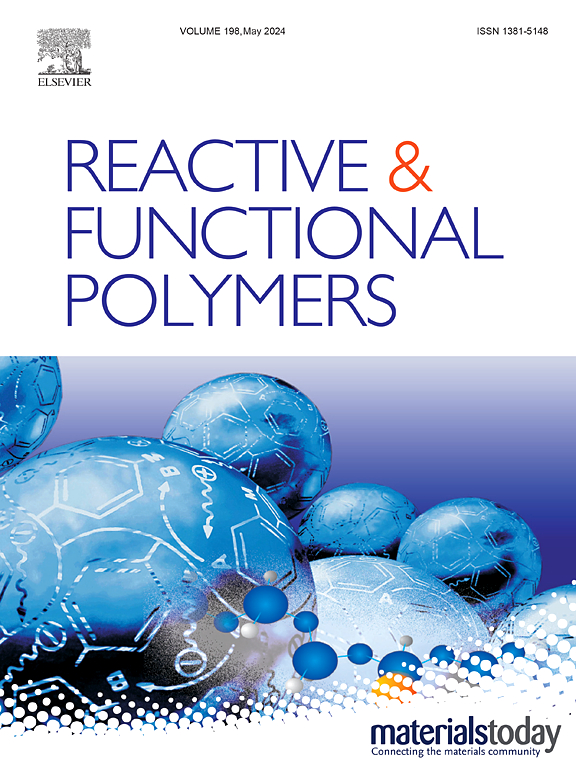通过应变诱导的网络重组增强天然橡胶的热氧化稳定性
IF 4.5
3区 工程技术
Q1 CHEMISTRY, APPLIED
引用次数: 0
摘要
橡胶材料在使用过程中经常受到光、热、氧等环境因素的降解。然而,传统的保护方法往往涉及在加工过程中添加抗氧化剂,这不仅会造成严重的环境污染,而且限制了橡胶制品在生物医学领域的适用性。因此,制定稳健的减缓老化战略是确保材料寿命的关键。本研究提出了一种可行有效的策略:通过预拉伸诱导橡胶中的网络重排,获得更稳定的交联结构,从而提高其热氧化稳定性。在硫化过程中,橡胶的交联网络中形成了多硫键和二硫键。预拉伸优先破坏弱键,在拉伸过程中诱导多硫键转化为二硫键。这种由应变引起的网状重排提高了橡胶的刚性和稳定性。在升高的温度下,这种机制变得更加明显。在热氧化老化的初始阶段,预拉伸触发了多硫化物向二硫化物键的快速转化。由于二硫键在热氧化条件下具有较高的键能和稳定性,橡胶的耐老化性能得到了显著提高。原子力显微镜测试和力学测试均表明,拉伸诱导交联网络中硫键的动态转变,导致热氧化条件下空间异质性的显著变化。结果表明,热氧化老化24 h后,天然橡胶的抗拉强度保留率由58.6%提高到81.1%。该研究不仅为抗热氧化弹性体的总体设计提供了重要指导,而且促进了对热-力耦合条件下橡胶网络演化机制的理解。本文章由计算机程序翻译,如有差异,请以英文原文为准。

Enhancement of thermo-oxidative stability in natural rubber via strain-induced network reorganization
Rubber materials are frequently degraded by environmental factors such as light, heat and oxygen during service. Conventional protective approaches, however, often involve adding antioxidants during processing, which not only causes significant environmental pollution but also limits the applicability of rubber products in the biomedical field. Therefore, developing robust aging mitigation strategies constitutes a critical imperative to ensure material longevity. This study proposes a feasible and effective strategy: inducing network rearrangement in rubber through pre-stretching to achieve a more stable crosslinked structure, thereby enhancing its thermo-oxidative stability. During vulcanization, polysulfide and disulfide bonds are formed in the crosslinking network of rubber. Pre-stretching preferentially broke weaker bonds, inducing the conversion of polysulfide bonds to disulfide bonds during the stretching process. This strain-induced network rearrangement enhanced the rigidity and stability of rubber. At elevated temperatures, this mechanism became more pronounced. Pre-stretching triggered rapid conversion of polysulfide to disulfide bonds during the initial stages of thermo-oxidative aging. Given the higher bond energy and stability of disulfide bonds under thermal-oxidative conditions, the aging resistance of rubber is significantly improved. Both atomic force microscopy tests and mechanical tests demonstrated that stretching induced dynamic transformation of sulfur bonds in the crosslinking network, leading to significant changes in spatial heterogeneity under thermo-oxidative conditions. As a result, the thermo-oxidative resistance of natural rubber was enhanced, with the retention of tensile strength increasing from 58.6 % to 81.1 % after 24 h of thermo-oxidative aging. This study not only provided important guidance for the general design of thermo-oxidation-resistant elastomers but also advanced the understanding of rubber network evolution mechanisms under thermo-mechanical coupling conditions.
求助全文
通过发布文献求助,成功后即可免费获取论文全文。
去求助
来源期刊

Reactive & Functional Polymers
工程技术-高分子科学
CiteScore
8.90
自引率
5.90%
发文量
259
审稿时长
27 days
期刊介绍:
Reactive & Functional Polymers provides a forum to disseminate original ideas, concepts and developments in the science and technology of polymers with functional groups, which impart specific chemical reactivity or physical, chemical, structural, biological, and pharmacological functionality. The scope covers organic polymers, acting for instance as reagents, catalysts, templates, ion-exchangers, selective sorbents, chelating or antimicrobial agents, drug carriers, sensors, membranes, and hydrogels. This also includes reactive cross-linkable prepolymers and high-performance thermosetting polymers, natural or degradable polymers, conducting polymers, and porous polymers.
Original research articles must contain thorough molecular and material characterization data on synthesis of the above polymers in combination with their applications. Applications include but are not limited to catalysis, water or effluent treatment, separations and recovery, electronics and information storage, energy conversion, encapsulation, or adhesion.
 求助内容:
求助内容: 应助结果提醒方式:
应助结果提醒方式:


